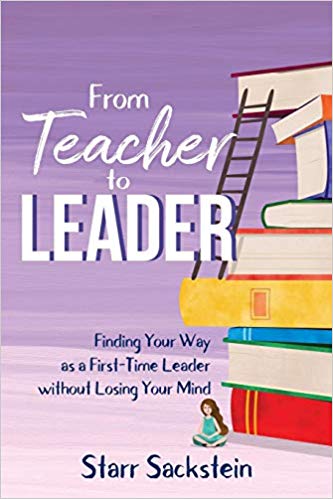
From Teacher to Leader: Finding Your Way as a First-Time Leader—Without Losing Your Mind by Starr Sackstein recounts her first year as an administrator. This story of a remarkably gifted teacher’s journey into administration after her first year is a great read. Starr’s reflections, research efforts, and writing skills have resulted in a valuable resource for teachers considering a jump to administration and experienced administrators alike. She lives up to her desire of becoming the kind of leader she would want to have. As an educator since 1969 and an administrator for 30 years, I find her advice to be spot on. Make sure that you and your professional development library has a copy.
Forward
- The forward by Dan Rehman, Superintendent West Hempstead Union Free School District tells the story of how Starr was hired as the district’s director of Humanities. While she clearly had the necessary qualities, she lacked the necessary certification, which Starr and the district were finally able to work around. Dan paints her as enthusiastic, goal focused, persistent, self-aware, creative, innovative, willing to take risks, and reflective. What else could you ask for in a leader?
- While she loved her nine years teaching journalism in New York City, (16 years total) she struggled with boredom and dissatisfaction with administrative decisions, and began experimenting with grading less and helping students began a flurry of reflection and problem-solving. She questioned what learning should look like. She became an administrator to become a mentor for new teachers. This book tells the story of her first year, mistakes and all.
- Each chapter also ends with some valuable Daily Reflections for Change that you can do.
1. To Leave or Not to Leave
- As a teacher, there is no single right way to know when to leave. Possible reasons are boredom or complacency with your work, urge to share your expertise with others, or someone suggesting that you make the move. (Doug: They also make more money.) Once you start to think about it the more you need to look for administrative programs. Ideally, you find one where you can take a few courses as a non-matriculated student to get your feet wet. Interview working administrators to get a better idea of what the job entails. Read some of the books Starr suggests and look for Twitter chats on leadership.
- Thirteen years into teaching Starr was able to take on a “hybrid” role as part teacher and part teacher coach. She felt that still doing some teaching gave her more credibility with the people she coached as she was still doing the things that she was trying to get them to do. Teachers could visit her classroom and she could still continue to try new things.
- Before you start looking for jobs create a description for your ideal job. Starr provides one here based on her desires and skills. Once you have your goals spelled out you can better articulate them in interviews. While no two people take the same path to administration, Starr’s path covers the basics that all teachers need to consider. She suggests that you are not there to fix teachers but to help them further develop the skills they already possess. Stay humble, be present, listen, collaborate, and be patient.
2. Teacher Leadership as a Precursor to School Leadership
- Consider the job description and ask a lot of questions about the school culture and needs to make sure the job is a good fit. Before transitioning grow your content or pedagogical expertise and serve on committees. Apply to present at local, regional, or national conferences on topics important to you. Adult learners are different from students. How so? Nothing is worse than discounting ideas elicited from others. It’s a surefire way to make your team resent you.
3. The Ache of the Shift
- Starr became very aware of the void that had been created inside by not being in the classroom. She worked to rebrand her decision as an extension of her teaching career and not as a replacement for it. She spends time in classrooms. Plans with teachers and offers to co-teach when it is appropriate. As a new team leader, you will definitely experience isolation. For the most part, it will continue because you are no longer part of us. Now you are one of them. Leadership doesn’t have to be the dark side. It can be light, optimistic, and supportive, but it definitely takes time to get your team to believe you are one of them. To get feedback Starr uses anonymous Google forms. Be ready with “Plan B” in the event your day changes unexpectedly. Starr also offers advice on attire here. Learning—in the classroom and in life—happens moments forced her to figure things out. You are going to have to do a lot of learning so it helps if you enjoy learning. Exhibit the behaviors you’d like to see.





